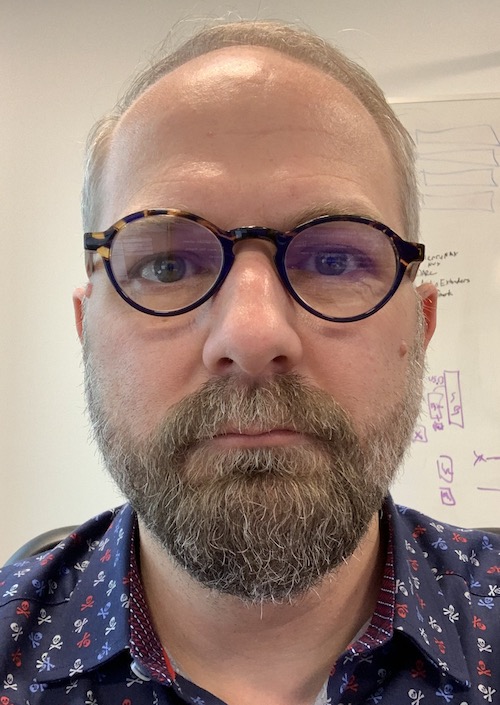The AV industry is all about innovation. But for the past year, our creative energies have been devoted not to shaping the future, but solving the problems of the present.
But larger trends are nonetheless having incremental influence over the direction we’re heading. As the powerful capabilities of things like 5G connectivity, artificial intelligence, and cloud computing direct the technology world as a whole, how is pro AV incorporating them to create a more capable and intuitive future?
Related: Tech Trends That WON’T Happen in 2021
We reached out to leading AV manufacturers to find out how prominent emerging trends are playing into their product development roadmaps.
Biamp

Joe Andrulis
Unlike most consumer- or commercial-grade products that are limited in the size and complexity of the problems they address, pro AV solutions can be configured and optimized for nearly any task, environment, and audio or video challenge. An ongoing problem for integrators is finding, training, and retaining skilled technicians who can program and tune pro AV systems properly to take advantage of their full potential.
New technologies present an exciting opportunity to help integrators and tech managers address this challenge by automating many of the mundane tasks that absorb precious time of these valuable workers. Modern systems can often automatically detect and configure the various pieces of equipment connected in a system, measure audio and video characteristics of the environment, make basic tuning and optimization decisions, and offer recommendations on how to overcome detected challenges, allowing technicians to focus on higher-value tasks. The result is faster, more consistent installations that are more profitable for the integrator.
New technologies will benefit end users as well. End users can be overwhelmed or distracted by complex AV gear. To make the benefits of these systems more accessible to even untrained users, we can use automation, natural language processing, predictive analysis, and other techniques to anticipate and satisfy users’ needs without their command or need to respond to spoken commands and gestures, making the AV systems a more transparent and natural tool for all users.
Crestron

Andrew Ludke
More and more AV devices have moved to the edge of the network where they provide a gateway to and from the network. We believe this will be further accelerated by the increased bandwidth and low power consumption of 5G-capable devices running micro apps locally and feeding data aggregators at the edge of the network that connect to cloud applications.
Network-connected AV edge devices are now important sources of data that can be aggregated in cloud applications to support new AI, ML, and BI applications (Big Data). With the growing number of devices, managing this technology ecosystem at scale while enabling unparalleled levels of business insight and integration is a challenge that is being addressed by solutions like Crestron XiO Cloud and our VC-4 platform. These virtualized and cloud-based solutions will continue to expand in capability and reach, upending traditional AV system provisioning, monitoring, and management and control methodologies.
These innovative solutions enable support for all devices, including third-party and legacy, which provides a total solution. This also delivers investment protection and brings new levels of insight and capabilities. We can now monitor and manage all devices, whether new and old or first-party, third-party, intelligent, and relatively basic devices.
With robust APIs to ensure easy integration and access to data, these solutions are driving new business models and a whole new world of connected, intelligent, and automated services. Crestron will continue to make cloud-connected solutions a core tenant of our product strategy, building native cloud connectivity into every product and solution we develop. 5G networking, cloud computing, analytics, big data, and AI/ML/BI applications will enable new business and service models for provisioning, monitoring, remote troubleshooting, and more. It is this synthesis of technologies that we believe is most exciting.
Harman

Jamie Trader
AI is less of an emerging technology as it is a way of thinking about the role and progress of programming. Artificial intelligence, since the 60s, is just about deriving computational decisions based on the outcomes of other computational results. The math has gotten harder as the data inputs have increased exponentially since then, but the technology principle persists.
The real evolution of pro AV has come from the on-demand availability of system storage, computational power, and the distributed functions associated with cloud computing. For example, it’s cloud computing’s enablement of the modern soft codec that has universally transformed what corporate AV systems are designed to accommodate.
Employing more cloud computing in technology design, pro AV is able to better recognize and solve for the complex needs of the technology user with scale, efficiency, and simplicity. But more importantly, it’s transforming the tools and work streams that commercial integrators leverage to design, configure, commission, program, measure, manage, and monetize these systems.
Enabling and improving this commercial transformation through the use of cloud computing is both exciting and necessary to pro AV—and what you can continue to expect from iconic Harman brands including AMX and BSS.
Kramer

Yuval Kramer
From a professional AV perspective, we focus on integration. Within Kramer specifically, we deliver end-to-end solutions that provide users with a complete package. The subject of this integration however has shifted since emerging technologies including AI, 5G, and the cloud have been in play.
We are no longer focused on connecting boxes now; as spaces are becoming smarter, we are focused on connecting the people to the system. The new role of AV is to make sure that the people are running the space, not that the space is running the people.
The impact of AI on this is that it can anticipate what people want to do by the actions that they are performing, and we can build in more automation. If they go to the podium in a lecture theatre, for example, they probably want to start presenting, so the microphone needs to be on, their content needs to appear on the screen, the camera could start recording, and a simple UI could appear that allows them to control their slideshow without explanation.
Of all the new developments, I think 5G and low-energy wireless communication signals, like Bluetooth 5.0, are the most exciting. By removing the challenges of bandwidth, we remove a lot of the limitations and people won’t just be able to work from anywhere, they will be able to work from anywhere efficiently. With no wires, we can also reimagine the way we design spaces to be more efficient and present new opportunities.
QSC

Martin Barbour
Big Data offers users the opportunity to learn more about their organization’s behavior in order to make better, more informed decisions. Our industry has used big data for space planning, technology purchasing decisions, and other areas of facilities management for years, but combined with other technologies such as AI and Machine Learning, the opportunities expand rapidly. With this information at our fingertips, data-driven automation is more achievable and operations support is simplified, like ensuring the required resources are available for a given meeting, or creating the opportunity to move a meeting to a room that better suits the topic. Q-SYS Reflect Enterprise Manager remote monitoring and management service lays the groundwork for users to aggregate large amounts of data from its entire AV estate (regardless of where its located in the world), and begin to realize the business outcomes afforded by having this new visibility of assets.
With the introduction of the Q-SYS Core 5200, QSC proved that proprietary hardware was not the cornerstone of delivering integrated audio, video, and control solution; it could be delivered as a software application, namely the Q-SYS Core OS. Several years ago, QSC demonstrated this by working with Dell to couple the Q-SYS Core OS with existing a common off-the-shelf server based on Intel x86 architecture. This opened up a massive opportunity to leverage other x86-capable hardware as a deployment solution for Q-SYS.
Furthermore, QSC recognized Cloud Computing as a mature technology where we could once again leverage mainstream and proven technology for certain aspects of our growing and evolving Q-SYS platform. Because of the platform’s IT foundation, we were able to again extend customer value by adding a cloud-based RMM solution, Q-SYS Reflect Enterprise Manager.
Sony

Rich Ventura
With COVID putting health and wellness in the spotlight, AI, facial detection/recognition, sensors, and data have taken an interesting turn. In the past, consumers were concerned about sharing their data and personal information for fear of how it was being used. Today, our culture has become more open about sharing these insights as it pertains to the wellbeing and safety of themselves and others and we recognize the value of solutions like contact tracing. We understand and seek comfort in infrared temperature scans when we enter a building. While privacy is still a primary concern, we are realizing that technology is helping to facilitate beneficial and critical information and experiences that contribute to people’s livelihood.
The pandemic has also accelerated a move to touchless solutions, driving a resurgence in technologies like QR codes, which are now implemented in everything from restaurants to healthcare lobbies and even smart TV setup, to make the process hands-free or centralized through our personal devices. The information being gathered through sources like QR codes is helping to deliver more programmatic and tailored experiences based on the engagement. I expect even more creative uses of technology to come to the forefront as we seek new ways to foster engagement, customize experiences, promote collaboration, and move toward a safer and smarter future.

